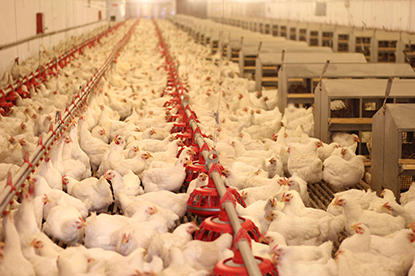
| May 2015 | |||||||||||
| Top stories | |||||||||||
| In the news | |||||||||||
| Photos | |||||||||||
| Contact us | |||||||||||
| Archive | |||||||||||
|
Avian influenza in Iowa spurs emergency declaration |
Cases of a high pathogenic strain of avian influenza (H5N2) have been identified in poultry flocks in 11 Iowa counties, in the northwest part of the state and in central Iowa’s Madison County. As of May 8, 37 cases were confirmed. According to the Iowa Department of Agriculture, 21 million birds in Iowa flocks are affected by the outbreak.
Gov. Terry Branstad declared a state of emergency on May 1, authorizing the use of state resources to contain H5N2.

The Iowa Department of Public Health, in collaboration with local public health partners, is following up with workers who had direct contact with infected birds to confirm that they stay well. Public health staff will contact workers daily until 10 days after their last unprotected exposure to infected birds. In addition, in accordance with the Centers for Disease Control and Prevention guidance, it will be recommended that workers with direct unprotected exposure to infected birds consider taking 75mg of antiviral medication twice daily for seven days.
This H5N2 high pathogenic strain of influenza is a new strain that originated in and is being spread by waterfowl, gulls and shorebirds as they fly throughout Iowa. This strain of influenza has not caused illness in people, and the risk to the public health is very low. There are no food safety concerns; any risk of infection would be limited to people in direct contact with infected birds.
“While it is true that this version of the flu does not affect humans, the literature shows that some poultry workers have developed antibodies against it,” said Director of Disease Control Wade Aldous. “The potential for a shift is possible, but the probability would be extremely low.”
Test Guidance
Currently, the CDC recommends that avian influenza be considered by health care professionals as a possible diagnosis in people with influenza-like illness (ILI) that have had recent contact with sick or dead birds, especially in areas where the virus has been identified. Rapid and commercial influenza tests (including RT-PCR) may not be able to identify influenza in people infected with influenza A H5 viruses. For this reason, these tests should not be relied on to preliminarily identify avian influenza strains in people.
The State Hygienic Laboratory can test for avian influenza from human specimens. Submit specimens and request an influenza RT-PCR test. This test detects all strains of influenza. If the test is positive, it will be strain-typed. Additional information is available online: https://www.shl.uiowa.edu/dcd/influenza/index.xml.